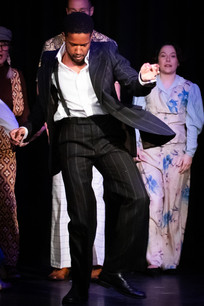Company - CODA
- Alexa Keeble

- May 11
- 3 min read
Updated: May 12
By Alexa Keeble
Stephen Sondheim's "Company" marked a triumphant return to musical theatre for CODA, as it was their first full musical since COVID. Under the passionate direction of Jody Tranter, along with assistant director Deborah Liu and musical director James Moriarty, the company embraced a minimalist aesthetic. The costumes, designed by Priscillia Adegbenle, set the show in the original period, while the staging allowed Sondheim's intricate score and emotionally complex lyrics to take centre stage. The result was an engaging and intelligent production, proving to be ambitious and rewarding for both the cast and the audience.
Set in the 1970s, the story revolves around bachelor Bobby as he celebrates his 35th birthday. Unlike his many friends, Bobby is single, and through a series of short stories, we see his interactions with various couples, each revealing different dynamics of marriage and companionship. The narrative does not follow a traditional linear plot but instead depicts Bobby's internal conflict regarding love and commitment.

"Company" is an excellent choice for an amateur dramatics society. With a wide range of roles and character-driven scenes, it allowed CODA to showcase the depth and versatility of local talent. The 14-person cast blended seamlessly, demonstrating strong chemistry between each couple. Much time clearly went into developing the relationships between characters, resulting in genuine performances.
The musical director, James Moriarty, provided a single piano accompaniment that was very effective. The stripped-back musical arrangement and minimalist style allowed the cast's talents to shine through, creating intimacy between the performers and the audience. His musical direction was clear, confident, and precise. The entire cast delivered strong vocal performances, but I was particularly captivated by the vocals of Nick Beever (Harry) and Karen Rapps (Joanne).
In the central role of Bobby, newcomer Richener Bissereth delivered a charismatic performance. Bobby navigated the fine line between being endearing and emotionally distant. Richener captured the complexities of a man loved by many but unable—or perhaps unwilling—to fully open himself to love in return. His rendition of "Being Alive" was a highlight of the night, delivered with a potent mix of strength and vulnerability. There were moments in the song when he stepped slightly out of the spotlight, which detracted a bit from the overall impact, but when fully lit, he truly embodied the character.
Photographs by Paul Grace
Sondheim's compositions are famously intricate and vocally demanding, yet the cast made them appear effortless. One standout moment came from Lucrezia Phifer in the role of Amy. Her performance of "Getting Married Today" was nothing short of exhilarating, executed with precision and theatrical flair. The audience responded with an explosion of applause—the loudest and longest cheer of the evening. Maintaining the song's momentum is a significant challenge for any actor. Still, Lucrezia fully embraced the challenge, commanding the stage and contrasting beautifully with the soft, loving vocals of Jonathan Graham (Paul). I spoke to the director during the interval, and he mentioned he had planned to slow down the song until he witnessed Lucrezia's capabilities.
Each couple contributed something distinct and entertaining to the show. Special mentions should go to Hannah Mooney (Sarah) and Nick Beever (Harry), as well as Bee Edwards (Jenny) and Alex Cooper (David), whose comedic timing and chemistry brought warmth and laughter to their scenes.
Mérédith Heinrich (Marta), Jemma Moylan-Torke (Kathy), and Emily Mackan (April) brought Bobby's three girlfriends (or ex-girlfriends) to life. Their contrasting performances showcased each character's quirks and highlighted Bobby's conflicting desires.
The show does not rely heavily on choreography, and choreographer Eddie Elliott wisely embraced this choice. He kept movements simple, focusing instead on thoughtful blocking and the use of space to keep the songs visually interesting.
Act Two opens with the energetic number "Side by Side by Side," which features more defined choreography. This scene was a joy to watch, as the cast made full use of the stage in a joyful performance with traditional musical theatre movements. There were a few moments when synchronicity faltered; some cast members used the opposite arm or leg to their peers, slightly detracting from the visual lines' sharpness. Still, each performer committed fully to the dance, and their energy more than made up for any minor inconsistencies.
Overall, CODA's production of "Company" was a thoughtful and well-executed presentation that reminded audiences of the intimacy and brilliance of amateur theatre. As a charitable organisation, CODA demonstrated that a strong, engaging performance of a notoriously difficult musical does not require a large budget. Seeing the group show that you do not need a large budget to deliver a strong, engaging performance of a notoriously difficult musical was a pleasure.
Photographs by Paul Grace
Editors Note:
In short, CODA is back!
























Comments